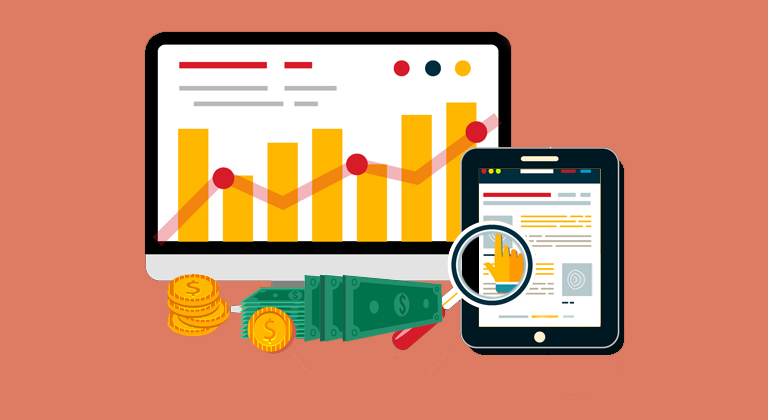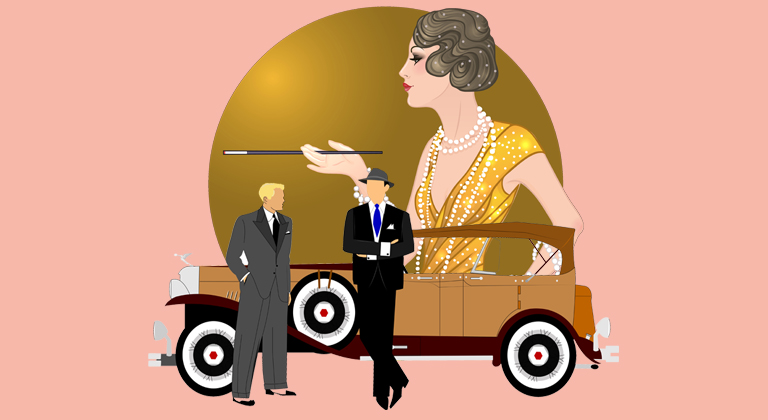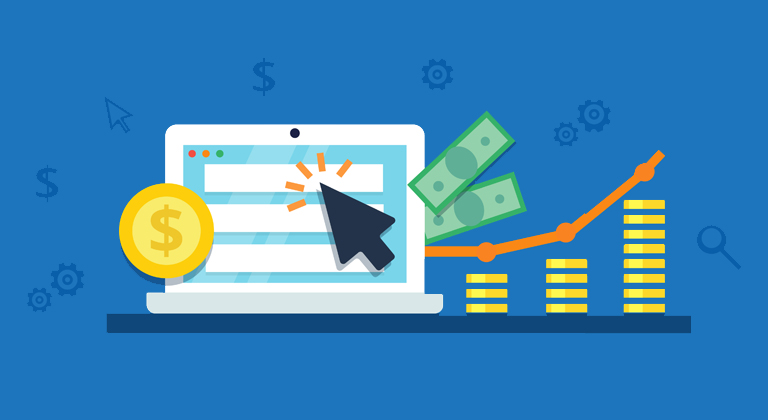Spending your first $1,000 on digital advertising
There’s an old adage: “You’ve got to spend money to make money.” Nowhere does this wisdom apply more than in the digital advertising industry – especially when it comes to the business of selling books online. However, it’s important to make sure that any money you spend provides some kind of value – even if it isn’t initially in direct book sales. Here are some of Ginger’s guidelines regarding what authors should focus on when spending their first $1,000 on advertising their books.
In 2020, advertisers spent $378 billion on digital advertising, and that looks set to double by 2024 – equivalent to the GDP of the nation of Somoa. Much of what’s driving this is access to self-service advertising platforms like Twitter, Instagram, and Facebook. Self-service ads generated $28.5 billion in revenue for Facebook last year, for example.
Authors comprise a significant number of those advertisers. In fact, the next step after successfully self-publishing a book is often to try and market it effectively. The good news is that there are many authors who generate a full-time income from advertising their books on platforms like Facebook.
However, the bad news is that they’re the exception, not the rule. In truth, there are significantly more authors who advertise on platforms like Facebook but never see a return on their investment. It can be frustrating and disheartening – often leading some authors to give up the game entirely.
But it needn’t be this way. Yes, you’ll have to “spend money to make money” on social media – and you might not see that money back for quite a while. However, if you spend your first $1,000 of advertising money wisely, the information that spending gives you could help you turn a deficit into a profit – and then potentially provide you with the tools to build a revenue-generating self-publishing business that can make you money consistently for years to come.
Now that is money well-spent.
Here are some things to think about:
Go Big or Go Home
The blessing and the curse of digital advertising is that it’s affordable. You can run campaigns on Facebook from as little as $5 a day, for example, and they’ll often reach thousands of potential readers. When a lot of self-published authors first turn to advertising, this is the kind of budget they’ll start out with – since it seems affordable, manageable, and unintimidating.
However, that’s also why it rarely provides satisfactory results. $5 a day isn’t generally enough money to noticeably move the needle on your book sales. Most authors who take this approach end up confused about whether their advertising is helping them make a profit or not.
That’s because your book doesn’t exist in a vacuum. If you’ve published it to Amazon, your book does have the opportunity to be discovered in a lot of different ways – far beyond just the ads you’re running.
Advertising on Amazon provides direct information about which clicks turned into sales, but it’s the only platform capable of doing so. Traffic ads on a platform like Facebook, for example, don’t provide any information about a potential reader’s activity after they click on your ad – so with a $5 daily budget, it’s difficult to know whether the sales you’re generating come from those ads or just from your book being discovered organically.
If you’re like me and constantly checking your book sales, it becomes frustrating. You can have some days in which you might bring in less than $5 in royalties, and days in which you might bring in $15 in royalties, but until you accumulate a month or more of data, it’s very difficult to take anything other than an educated guess at what kind of ROI your ads are actually providing (if any!)
This is why I think the first thing you need to focus on when advertising your books is spending big. Not ridiculously big, but just big enough to be able to tell, instantly and unequivocally, whether or not your ads are selling books.
A good starting point is $20 a day advertising on a platform like Facebook. If you spend $20 a day on ads over the course of a full week, it’s pretty impossible not to see whether or not those ads are working.
If you don’t see a spike in additional book sales the same day you begin running your ads, don’t panic. I strongly recommend you let those ads run for at least four or five days before calling it quits because they ‘don’t work.’ It might seem like you’re throwing money down the drain, but this kind of spend for this kind of period actually ends up providing a lot of valuable information – even if you’re not making sales!
With a budget of $20 a day, as opposed to $5, you’ll start to see real figures you can derive important information from to improve what you’re doing. If your ads aren’t generating clicks, for example, you’ll know you need to work on them. If your ads are generating clicks, but you’re not seeing an equivalent bump in book sales, you might be able to surmise that something on your product page is dissuading potential readers from clicking ‘buy now.’
Alternatively, you might find running your ads for a few days is all they needed to suddenly kick into gear. Maybe all those clicks you generated didn’t translate into immediate book sales – but perhaps the next time a user goes back into Amazon and sees your book in your Browsing History they’ll give it another chance. Alternatively, if you’re part of KDP Select, maybe somebody downloaded your book but didn’t start reading it yet. Time and patience are the important things here – since the sales and revenue you’d anticipated seeing might not immediately arrive.
I have a good personal example to share regarding this. I recently got locked out of my Facebook account because of a login glitch (don’t worry, it’s fixed now) and that cut short an advertising campaign I was running at $20 a day. I only had three days of advertising before it stopped.
At the time, I hadn’t seen a particularly impressive spike in book sales during those three days – but months later, when I went back to check the figures, I discovered that my $60 spend on Facebook ads had led to a $600 spike in KDP Select royalties and book sales that month! I knew that it had to be because of that advertising because I wasn’t promoting my books anywhere else at the time – so what had seemed like a failure when I looked at the figures day-by-day had actually ended up being hugely profitable.
So that’s the thing – you need to spend a significant amount of money over an extended period (at least four or five days) before you can really determine whether or not your advertising is working, and even then you can only really gauge that by comparing a similar period of time in which you weren’t advertising. It’s a slow process that rewards patience, but it does provide you with the one thing you need to make digital advertising successful: Data. After all, as management consultant Peter Drucker once famously said: “You can’t improve what you don’t measure.”
Now, obviously, you could measure this with an extended spend of just $5 a day for a week or so – but $5 is such an inconsequential amount that it would still be difficult to tell whether your advertising worked or not. Actually spending real amounts of money – even with the knowledge that you might never see any return for it – is how you can actually start seeing real information you can act upon.
So, with the first $1,000 you’ve committed to spending on advertising, I recommend doing short, concentrated bursts of high-budget advertising rather than long, drawn-out low-budget advertising – because these bursts will provide you with some real-time actionable data about whether or not people want to buy your book.
But what if it doesn’t work?
You start seeing real information about the salesworthiness (I might have just invented that word) of your book by increasing your advertising spend – but what if the information that reveals isn’t good? Because there is a definite possibility that if you increase your daily advertising spend from $5 a day to $20 a day, it won’t translate into any sudden spike in sales.
Again, I’ve experienced this myself! Last year I advertised a romance novel written under my own name (rather than my successful penname) and spent $25 a day for a week to see what kind of sales I could generate.
The answer? None.
I spent over $100 before I finally pulled the plug. Then, I waited to collect full data for the month and compared it to a month in which I hadn’t advertised the book – just so I didn’t miss any slow-burn increase in sales.
However, I soon realized that my advertising hadn’t increased or boosted sales of that book in any way. It was incredibly sobering to realize that people just didn’t want to buy this particular book.
And the most sobering part of it all? The knowledge that this is normal.
In truth, a lot of digital advertising doesn’t work. The problem isn’t the advertising or the budget – it’s the fact that when potential readers land on your product page, they simply don’t want to buy your product. Maybe it’s because the blurb turned them off. Maybe it was a typo in the Look Inside. In any event, it doesn’t matter how much money you spend on advertising if you’re advertising something people don’t want to buy.
But discovering that is often worth whatever amount of money you spent on advertising – and it’s something you might not have clued into so quickly if you’d been spending just $5 a day on Facebook ads. The whole idea of ‘go big or go home’ and spending at least $20 a day on ads is to see whether or not they work – and spending that amount for four or five days and not seeing an uptick in sales is pretty compelling evidence that your ads aren’t working.
The same can’t be said for spending just $5 a day on advertising. You could do that for a full month (so spend the same as five days of $20 a day ads) and still be unable to determine whether your ads are working or not. That means you’ll spend the same as you would on a higher-budget ‘burst’ of advertising – but get nothing back from it.
And discovering that your book isn’t selling is valuable. This is an opportunity, not an obstacle. If you’ve been running ads successfully, and if they have been driving clicks to your product page, then you’ve spent that money to learn that you need to improve your book (or, at least, how your book is presented to potential readers.) And it’s better to learn that sooner, rather than later.
Again, I speak from personal experience. When I first started advertising book one in my MC Romance series, I wasn’t making any money from advertising. People just weren’t buying the book.
They were, however, clicking on my ads – which told me it wasn’t the cover that was the problem.
After spending $20 a day for five days and seeing no uptick in sales, I reapproached the product page for my book and did something ridiculously simple – I changed the font size of my blurb. That meant the first four lines of my blurb were displayed before you got to the ‘read more’ link, as opposed to just two lines with a larger font. (This was before the Hidden Gems Blurb previewer tool that would have made it much easier to know what was going to appear before the Read More cutoff!)
The result? When I ran another 5-day block of advertising at $20 a day, I suddenly saw an uptick in sales. That minor change had made my book a more compelling purchase; and I discovered that I’d doubled the number of clicks that ultimately converted into a sale.
A few weeks later, I re-wrote the first few pages of my novel so that the Look Inside was more compelling, too. After another week of experimenting with advertising, I observed that I’d once again doubled the number of clicks that ultimately resulted in a sale. This was the moment at which my advertising became profitable.
So, theoretically my first two weeks of advertising (spending a not inconsequential $200) had been a failure. I hadn’t sold any books.
Except that’s not true – because it had given me the information I needed to change elements of my product page, and that resulted in profitable advertising. As frustrating as it was at the time (I nearly pulled the plug on both campaigns) I now can’t complain about ‘wasting’ that $200 because I’ve made it back dozens of times since thanks to the information it provided.
Spend in short, controlled bursts until you make a profit
Different authors are in different situations. For some, spending $1,000 on advertising is something they can afford to do. For others, it might take weeks to save up that much – and it’s alarming to think you might be spending it without ever seeing any of it back (at first.)
But this is the only path to being able to make a continuous, passive profit from advertising your book. You have to take this step, otherwise you’ll never get to a position in which your books literally sell themselves. It’s one of the many challenges that only people truly committed to making a full-time living as an author can overcome.
So, use the first $1,000 you spend on advertising wisely. Don’t be afraid to spend much more than you might feel comfortable about – but be aware that you might not see any of it back for a while. That’s why advertising budgets should be like gambling budgets – money you can afford to lose.
And not everyone will need to spend $1000 figuring it all out. It make take a few iterations of these short and controlled bursts to gather the info you need to improve your results, or maybe it will only take one. And hopefully with each new book you publish and advertise, the path to profitability will get even shorter and cheaper.
But short, controlled bursts of higher-budget spend will help you learn so much about your book and how to improve it. Think of each one like shooting an arrow. Sure, you’ll miss the target first time out – but if you adjust your stance and aim for the next arrow, you’ll be able to see yourself getting closer to the bullseye.
Becoming a successful author doesn’t just require writing a book. It requires writing a book packaged and published in a format that makes people want to read it. If you use your advertising budget to provide information you can use to adjust your blurb, Look Inside, and other aspects of your product page on Amazon, you’ll get closer and closer to finding that perfect format. After you do that? Well, advertising can become profitable – and you can start building the career you’ve always wanted as an author.












Interesting and useful. Thanks, Ginger.
Great advice! Thank you, Ginger.